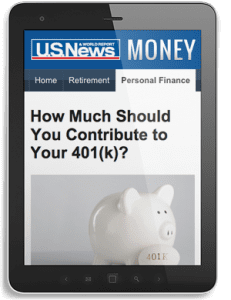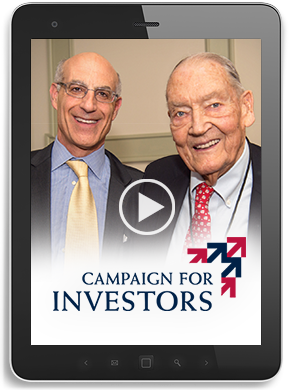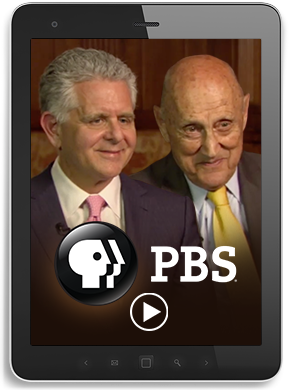How Much Should You Contribute to Your 401(k)?
Our very own Sally Brandon talks about how important it is to contribute whatever you can to your 401(k) and to strive to increase that percentage over time.
Even if you can only save a tiny amount now, your contributions will pay off down the road.
 Most employees with a 401(k) understand, on some level, that it would be in their best interest to salt away money for retirement. However, many workers live paycheck to paycheck, relying on every penny of take-home pay. It may seem impossible to invest for the future, but across the board, financial advisors recommend putting away as much as possible, even if it is a tiny amount to begin with.
Most employees with a 401(k) understand, on some level, that it would be in their best interest to salt away money for retirement. However, many workers live paycheck to paycheck, relying on every penny of take-home pay. It may seem impossible to invest for the future, but across the board, financial advisors recommend putting away as much as possible, even if it is a tiny amount to begin with.
“I encourage people to at least start with something and see how it feels,” says Sean Burgess, founder and principal at Burgess Financial Planning in San Francisco. “If they truly are unable to make it happen, and this is forcing them into credit card debt, then it’s not going to work. But they may surprise themselves that they can start with a 5 percent contribution and still make ends meet.”
That’s especially important, he says, as the number of defined-benefit pension plans dwindles. According to a 2013 Bureau of Labor Statistics white paper, 35 percent of private-sector workers in the early 1990s were covered by a pension. By 2011, that portion shrunk to 18 percent.
In addition, many existing corporate pension plans are closed to new employees. As employees with longer tenure leave the company, the percentage of workers covered by these pension plans will decline.
“You’ve got to force yourself to save. Companies used to provide pension plans and do the saving on behalf of the employee. Now, with that gone, there is no choice. At some point, we have to fund our own pension plans,” Burgess says.
The federal government offers incentives to save. Employer-sponsored qualified plans allow people to invest with pretax dollars. Investors enjoy portfolio growth with no tax consequences until they begin making withdrawals. Investors can begin making withdrawals at age 59½, and the IRS requires minimum withdrawals starting at age 70½.
People over 70½ who are still working may delay 401(k) withdrawals until April 1 of the year following their retirement. That differs from the rules for an individual retirement account, which requires withdrawals at age 70½, even if the account owner is still working.
Because of the tax treatment, employer-sponsored plans are a good deal, and become even better when the employer offers a match on some percentage of savings. An employee should never forego an employer match, Burgess says. “Even if they think they can’t afford it, it’s such a no-brainer to contribute up to that match. It’s a 50 percent to 100 percent automatic investment return,” he says.
Sally Brandon is vice president of client services at Rebalance, a Palo Alto, California, firm that helps investors allocate their retirement plans in a way that minimize fees. Like Burgess, she also recommends investing in a 401(k) at least up to the employer match, and striving to increase that percentage over time.
For 2015, 401(k) contribution limits total $18,000. Workers age 50 and older are allowed an additional catch-up contribution of $6,000. For people who have decided to contribute to their plan but are unsure of how to choose investments, Brandon suggests target-date funds, if those are available within an investor’s 401(k) plan. These automatically rebalance a mix of stocks, bonds and cash at predetermined intervals. Retirement target-date funds contain an asset mix appropriate for a person leaving the workforce within a particular time frame.
She also emphasizes monitoring 401(k) fees, which may negatively affect performance. “It’s not only important that people save as much as they can, but when they’re saving in their 401(k), contact the [human resources] department and get a good understanding of fees,” she says.
In situations where the plan’s offerings are expensive relative to other investments, Brandon says investors should ask for other options. “Talk to HR, and see if there is a way to expand the choices. If there is an opportunity to have offerings with lower fees, that will serve them well in the long run,” she says.
In addition to recommending people save as much as possible and allocate efficiently, advisors say investors should begin envisioning retirement early, perhaps even decades before they plan to leave the workforce. Stace Hilbrant, managing director and founder of 401k Advisors in Wilmette, Illinois, acknowledges that it’s no easy task for workers in their 20s, 30s and 40s to imagine themselves old. However, envisioning one’s “future self” is a way to emotionally connect with the idea of saving a portion of every paycheck.
“Start by defining what you want your retirement to look like. That requires planning, and that’s where people get off the boat. It’s no fun. But don’t start with what you should defer. Start with what you want your retirement to look like,” Hilbrant says.
His firm provides independent consulting and advisory services to retirement plan sponsors. It helps plan sponsors educate participants about their 401(k) contributions and investment choices. Hilbrant says workers have to understand that with rising American life expectancies, retirement may last 30 years or more.
“We teach people that retirement is not the five-year period you thought it was. It’s much longer. We want people to take ownership of what the outcome is going to look like, and from there go backwards and plan,” Hilbrant says.
“If you can get yourself to a 10 percent or 12 percent deferral, you can virtually assure yourself of having a comfortable, adequate retirement,” he adds. “That’s the payoff. But to find a way to get that money from the family budget, you have to connect it with the question, ‘Why am I doing this?’ Otherwise, it’s just one more line-item deduction from your paycheck.”
However, the bottom line for Americans remains: Save as much as you possibly can.
“We’re at a crisis in this country. Until people figure out how to make this a priority in their lives, we’re going to have a problem,” Hilbrant says. “The days of being satisfied with putting away 3 or 4 percent – that just doesn’t cut it, and it will leave you in the same crisis mode that everybody else is in.”






